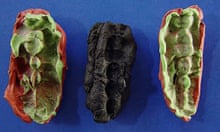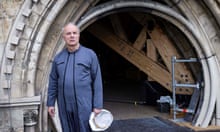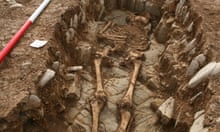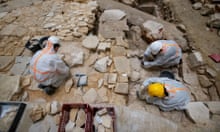Two lead sarcophaguses discovered buried under the nave at Notre Dame Cathedral in what was described as an “extraordinary and emotional” find have begun giving up their secrets, French scientists announced on Friday.
The first contains the remains of a high priest who died in 1710 after what experts say appeared to be a sedentary life. The occupant of the second has not yet been identified – and may never be – but is believed to be a young, wealthy and privileged noble who could have lived as far back as the 14th century.
The tombs were uncovered as part of a cache of statues, sculptures and fragments of the cathedral’s original 13th-century rood screen buried under the floor of the transept crossing at the heart of the cathedral that was ravaged by fire in April 2019.
The burial sites were described as of “remarkable scientific quality” and were found after a preventive dig under the floor where heavy scaffolding is to be erected to install the cathedral’s new spire.
While most of the treasures were discovered barely 20cm (8in) under the cathedral floor, a body-shaped lead sarcophagus was buried one metre deep.
Once opened by specialists in Toulouse, it was found to contain what was left of a man, probably in his 30s, who researchers have named “Le Cavalier”, as his pelvic bones suggest he was an experienced horseman.
There was no name plaque on the coffin, which was moulded around the shape of the body, and holes in the lead around the head meant the remains had been exposed to the air and severe deterioration.
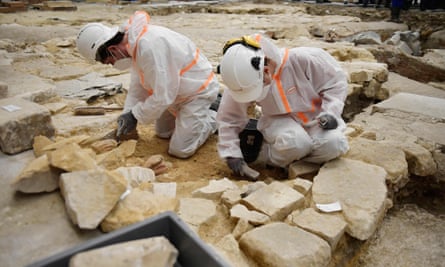
Scientists are continuing to examine fragments of cloth and plant material found inside the coffin and say he was embalmed – a rare practice in the middle ages – and appears to have been buried with a crown of flowers.
A brass plaque on the second lead sarcophagus, also exposed to the air and water infiltration from the historic flooding of the Seine in 1910, confirmed that it contained the remains of Antoine de la Porte, the canon of Notre Dame Cathedral who died on Christmas Eve 1710 aged 83.
Eric Crubézy, professor of biological anthropology at the University of Toulouse III, who oversaw the cutting open of the coffins, said the two men were clearly important in their respective eras to have been buried in such prestigious tombs at the heart of the cathedral.
The unknown cavalier would have been a member of “the elite” at the time of his death to have been interred at the foot of the large cross on the since-destroyed rood screen, an ornate partition between the chancel and the nave that separated the clergy and choir from the congregation. Most rood screens were removed from France’s Catholic churches during the Counter-Reformation in the 16th and 17th centuries.
The young man had suffered a “chronic disease” that had destroyed most of his teeth by the time he died, Crubézy told journalists. “He would have had a difficult end of life.” The dead aristocrat also had a deformation of the skull caused by wearing a headdress or headband as a baby.

Christophe Besnier, who headed the scientific team for the dig carried out by France’s national archaeological institute, Inrap, told a press conference: “If the date of his death was around the second half of the 16th century or early 17th century, we may be able to identify him in the death register that we have. If it’s earlier than that, we probably won’t ever know who he was.”
Unlike the cavalier, de la Porte had “extraordinarily good teeth”, Crubézy said. “They were remarkable for his age. We see this very rarely, but he clearly cleaned his teeth and took care of them.”
De la Porte was rich, influential and not only commissioned several works of art that are now in the Louvre, including a painting by Jean Jouvenet entitled The Mass of Canon Antoine de la Porte, but paid 10,000 livres – a small fortune at the time – for the renovation of the choir of Notre Dame Cathedral. Part of the destroyed rood screen was used in constructing his tomb.
After fire swept through the 850-year-old cathedral, one of Paris’s most symbolic and visited monuments, in April 2019, almost destroying the entire edifice, President Emmanuel Macron pledged to have it rebuilt and open for mass in five years.
The Inrap team was called in to carry out a “preventive dig” under a section of the cathedral floor between February and April before a 30 metre-high, 600-tonne scaffold was built to reconstruct the monument’s spire. The archaeologists were given a strict timeframe and only a specific area in which to carry out the excavation.
Dominique Garcia, president of Inrap, reiterated that the human remains were not “archaeological objects” and would be treated “with respect from beginning to end” of the research before being returned to Paris for the culture ministry to decide what would happen to them.


